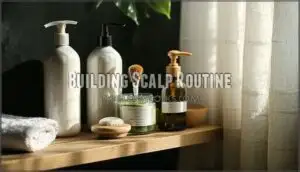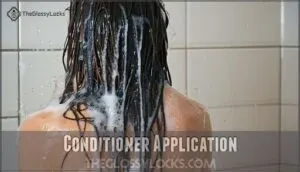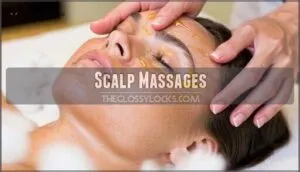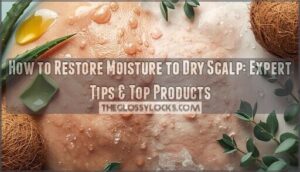This site is supported by our readers. We may earn a commission, at no cost to you, if you purchase through links.
 A scalp care routine for beginners doesn’t have to be rocket science. Start by washing your hair 2-3 times weekly with lukewarm water and a gentle shampoo that matches your scalp type.
A scalp care routine for beginners doesn’t have to be rocket science. Start by washing your hair 2-3 times weekly with lukewarm water and a gentle shampoo that matches your scalp type.
Always follow with conditioner, focusing on mid-lengths to ends. When detangling, use a wide-tooth comb on damp hair to prevent breakage.
Skip the heat tools when possible and let your hair air-dry instead. Don’t forget regular trims every 6-8 weeks to keep split ends at bay.
Think of your scalp like soil in a garden – it needs the right balance of moisture and care to help your hair flourish. The secret lies in understanding your unique scalp needs.
Table Of Contents
- Key Takeaways
- Scalp Care Basics
- Building Scalp Routine
- Choosing Right Products
- Advanced Scalp Techniques
- Maintaining Scalp Health
- Frequently Asked Questions (FAQs)
- How to start a scalp care routine?
- What is the best scalp care routine?
- What is a basic scalp treatment?
- How to do a scalp treatment step by step?
- Can scalp conditions be treated with diet?
- How often should I change pillowcases?
- Do scalp exercises improve hair growth?
- What causes sudden scalp sensitivity changes?
- Are scalp scrubs safe for daily use?
- Conclusion
Key Takeaways
- You’ll need to identify your scalp type first by doing a tissue paper test after skipping a wash day – this determines whether you need products for oily, dry, normal, or combination scalps.
- Wash your hair 2-3 times weekly with lukewarm water and gentle shampoo, then apply conditioner only to mid-lengths and ends while avoiding your roots to prevent oiliness.
- You should detangle wet hair gently using a wide-tooth comb starting from the bottom and working upward, then let your hair air-dry instead of using heat tools to prevent breakage.
- Consistency beats perfection – start with basic weekly scalp massages, monthly clarifying treatments, and regular trims every 6-8 weeks rather than trying to do everything at once.
Scalp Care Basics
Your scalp is the foundation of healthy hair, and understanding its unique needs can make all the difference in your hair care routine.
Think of your scalp like the soil in a garden—when it’s balanced and healthy, your hair naturally grows stronger and looks better, with a healthy scalp being the key to healthy hair.
Identifying Scalp Type
Finding your scalp type is like discovering your skin’s personality—it guides every product choice you’ll make.
Start with the tissue paper test: press it against your scalp after skipping a wash day.
- Oily Scalp: Tissue shows saturated, greasy spots
- Dry Scalp: Minimal oil transfer, feels tight and flaky
- Normal Scalp: Light oil marks without excess grease
- Combination Scalp: Oily roots with dry ends
Importance of PH Balance
Your scalp’s natural pH balance sits at 5.5, creating a protective shield against bacteria and infections.
When this balance tips toward alkaline, you’ll notice dryness, frizz, and damaged hair that won’t grow properly.
Ideal pH of 4.7 keeps your hair shiny and manageable, and choosing pH-balanced products with cannabinoid benefits can help restore balance.
Maintaining a healthy scalp helps balance the scalp microbiome and is crucial for a healthy scalp care routine.
Natural Hair Behavior
Understanding your hair’s natural quirks helps you build the perfect scalp care routine.
Skip products for three days to see how your hair behaves without interference. This reveals your true hair porosity, curl patterns, and how natural oils distribute.
Here’s what to observe:
- Oil production – Does your scalp feel greasy after one day or three?
- Curl patterns – Notice if your hair waves, curls, or stays straight naturally
- Hair elasticity – Gently stretch a strand to test its bounce-back strength
- Product absorption – See how quickly your hair soaks up moisture
Building Scalp Routine
Now that you’ve identified your scalp type and understand pH balance, it’s time to create a routine that actually works for your hair.
Building the right scalp care habits doesn’t have to be complicated, but it does require consistency and the right techniques for washing, conditioning, and protecting your hair from damage.
Washing and Conditioning
Mastery comes through proper washing and conditioning techniques that transform your scalp care routine.
You’ll want lukewarm water temperature to preserve natural oils while shampooing. Use a quarter-size product amount, massaging with fingertips using gentle shampooing techniques.
Apply conditioner to ends only, avoiding roots. Rinse thoroughly after each step.
Many people find gentle shampoo products beneficial for scalp health.
| Step | Technique |
|---|---|
| Water Temperature | Use lukewarm water to protect natural oils |
| Shampooing Technique | Massage scalp with fingertips, not nails |
| Product Amount | Quarter-size dollop prevents waste and buildup |
| Conditioning Tips | Apply to ends only, skip the roots |
Detangling and Drying
Wet hair is fragile, like holding a delicate flower. Your scalp care routine isn’t complete without proper detangling and drying techniques that prevent breakage.
Treat your wet hair like spun silk—one wrong move and those delicate strands snap beyond repair.
Here’s your gentle approach to detangling and drying:
- Start detangling from the bottom – Use a wide-toothed comb on wet hair, working upward to avoid pulling
- Choose air drying benefits over heat styling to reduce heat damage and maintain natural moisture
- Pat hair gently with a microfiber towel instead of rough rubbing that causes frizz
- Apply detangling products before combing to create slip and protect strands during the process
Trimming and Protecting
After proper drying, regular trimming keeps your hair care routine complete. You’ll need trims every 6-8 weeks for split end prevention and healthy growth. Sharp scissors prevent fraying that damages hair further.
| Hair Type | Trim Frequency | Protection Method | Sun Damage Control | Nutrient Focus |
|---|---|---|---|---|
| Fine Hair | Every 4-6 weeks | Silk pillowcases | SPF hair products | Protein-rich foods |
| Thick Hair | Every 8-10 weeks | Loose braids | Wide-brim hats | Iron and biotin |
| Curly Hair | Every 10-12 weeks | Satin scarves | UV-blocking oils | Omega-3 fatty acids |
| Damaged Hair | Every 4-5 weeks | Protective hairstyles | Indoor styling | Vitamin C sources |
| Normal Hair | Every 6-8 weeks | Heat protectants | Covered ponytails | Balanced diet |
Your scalp care routine steps should include protective hairstyles that don’t pull tight. To maintain moisture, consider leave-in conditioners after washing. Natural remedy use like coconut oil shields from environmental damage.
Hair damage prevention starts with nutrient-rich foods that strengthen from within. This scalp care for beginners approach keeps hair healthy between salon visits.
Choosing Right Products
You wouldn’t use face cream on your feet, so why treat all hair the same way?
Your scalp type determines which products will actually work, and picking the wrong shampoo can leave you with greasy roots or a desert-dry scalp that flakes like yesterday’s sunburn.
Shampoo Selection
Finding the right shampoo feels like dating—you’ll kiss a few frogs before finding your prince.
Check your scalp type first: oily scalps need clarifying formulas, while dry scalps crave hydrating shampoos with coconut or argan oil.
For oily hair, consider using a specialized shampoo product to address specific needs.
Skip sulfate concerns by choosing chemical-free options with gentle ingredients that promote a healthy scalp.
Your scalp care routine steps start with smart shampoo selection that matches your specific needs.
Conditioner Application
Most people slather conditioner everywhere, but smart application makes all the difference in your hair care routine steps. Apply conditioner to your hair’s mid-lengths and ends, avoiding roots to prevent oiliness.
Some find success with leave-in conditioner options.
Here’s your conditioner roadmap:
- Start with dime-sized amounts – you can always add more
- Work through sections systematically – like painting a fence
- Let it sit for 2-3 minutes – patience pays off
- Rinse thoroughly with cool water – no residue allowed
Deep Conditioning
Beyond regular conditioner, deep conditioning treatments give your hair the intensive hydration it craves.
Apply hair masks from mid-lengths to tips on clean, damp hair, avoiding your scalp.
DIY masks using honey and olive oil work wonderfully for moisture, while protein treatments strengthen damaged strands.
Leave treatments on for 3-20 minutes, then rinse with cool water to seal benefits.
Heat Protectants
You’re already investing in quality shampoo and conditioner—don’t let heat styling undo your progress.
Heat protectants create a barrier between your hair and styling tools, preventing damage from high temperatures.
Apply these products before blow-drying or curling to maintain your hair care routine’s effectiveness.
Choose lightweight formulas with copolymers and silicone for maximum protection without weighing hair down.
For those with 4C hair, consider products that reduce heat damage and add shine.
Advanced Scalp Techniques
Once you’ve mastered basic scalp care, you’re ready to level up with techniques that’ll transform your hair game from good to great.
These advanced methods include spacing out wash days, using clarifying treatments, giving yourself scalp massages that feel like mini spa sessions, and applying targeted serums that work while you sleep.
They are designed to help you achieve a great hair game by providing additional care and attention to your scalp.
Reducing Washing Frequency
Over-washing disrupts your scalp’s natural oil production, creating a cycle where hair becomes greasier faster.
Reduce your washing frequency gradually based on hair type—oily hair needs washing every 1-2 days, while curly hair thrives with weekly washes.
Use dry shampoo benefits between washes to absorb excess oil and maintain scalp oil regulation without constant product buildup, which helps regulate your scalp’s natural oil production.
Clarifying Shampoos
Product buildup acts like invisible weights on your hair, dulling its natural shine.
Clarifying shampoo becomes your reset button, removing stubborn residue from styling products, hard water, and pollution.
Use it weekly if you have oily hair, biweekly for normal types, and monthly for dry or chemically-treated strands.
This deep scalp cleansing step transforms your entire scalp care routine.
Scalp Massages
Five minutes of scalp massage benefits transform your hair care routine completely.
Regular scalp stimulation increases blood flow, delivering nutrients directly to hair follicles for improved growth. This simple technique reduces stress while promoting scalp health naturally.
It’s also worth noting that massage may help with androgenetic alopecia symptoms.
- Gentle circular motions: Use fingertips to massage in small circles, avoiding harsh pressure
- Oil infusion timing: Apply lightweight oils before massaging for enhanced scalp blood flow
- Tool usage options: Try gua sha tools or silicone brushes for varied scalp stimulation
- Frequency guide recommendation: Massage 2-3 times weekly during your regular scalp routine
Leave-on Serums
Think of leave-on serums as your scalp’s daily vitamin boost.
These lightweight treatments deliver concentrated nutrients directly to your scalp, promoting scalp rejuvenation and hydration benefits. Apply 1-2 drops to wet hair after shampooing for ideal scalp health.
| Serum Ingredients | Application Techniques | Product Recommendations |
|---|---|---|
| Hyaluronic Acid | Apply to wet scalp | Weekly treatments |
| Stem Cells | Massage gently | Twice daily use |
| Natural Oils | Focus on roots | Morning routine |
| Peptides | Use fingertips | Night application |
Maintaining Scalp Health
Once you’ve built your scalp care routine, keeping it healthy means avoiding the buildup that can sabotage your progress.
Think of your scalp like a garden—it needs consistent care, stress management, and protection from damage to help your hair grow strong and look its best.
Avoiding Scalp Buildup
Product residue from styling gels, dry shampoos, and heavy conditioners creates stubborn buildup that clogs your follicles.
Your scalp care routine needs weekly clarifying shampoo sessions to strip away accumulated grime. Try gentle scalp exfoliation methods like sugar scrubs or specialized brushes.
Hard water quality worsens buildup, so consider filtered shower heads. Protective styling prevents dirt accumulation between washes.
Overgrowth of yeast can lead to seborrheic dermatitis symptoms via seborrheic dermatitis symptoms, and it’s essential to address this issue for a healthy scalp, promoting hair growth.
Managing Stress
Your stress levels directly impact your scalp health.
High stress triggers cortisol production, which disrupts your scalp’s natural balance and can cause hair loss.
Combat this by eating nutritious foods, getting quality sleep, and exercising regularly.
Try relaxation techniques like deep breathing or meditation to manage stress effectively, which is crucial for supporting both your mental wellness and healthy scalp care routine.
Preventing Breakage
Hair breakage stems from multiple culprits that weaken your strands.
Tight hairstyles pull at hair follicles, causing damage over time. Nutrient deficiencies rob your hair of strength-building vitamins.
Sun damage and frequent hair dyeing create brittle, fragile locks.
Combat breakage with natural remedies like coconut oil treatments. Your hair care routine should prioritize gentle handling and protective styling to maintain maximum hair strength.
Promoting Hair Growth
Beyond just maintaining healthy hair, you can actively boost hair growth through targeted scalp care.
Daily scalp massages improve circulation and stimulate follicles, while natural oils like rosemary combat DHT blockers and reduce inflammation.
- Massage your scalp for 5 minutes daily with circular motions
- Apply rosemary or castor oil weekly as minoxidil alternatives
- Use nutrient-rich egg masks to address nutrient deficiencies
- Maintain scalp microbiome balance with gentle cleansing
- Practice scalp exfoliation guide techniques monthly
Frequently Asked Questions (FAQs)
How to start a scalp care routine?
Start with a weekly pre-wash oil treatment to remove buildup.
Shampoo your scalp gently, focusing on cleansing rather than hair lengths.
Follow with conditioner on ends only, then apply a hydrating scalp serum.
What is the best scalp care routine?
While you pamper your face daily, your scalp gets forgotten.
Here’s your game-changer: cleanse with gentle shampoo, massage weekly with oil, use clarifying treatments monthly, and hydrate with leave-in serums.
Simple wins.
What is a basic scalp treatment?
A basic scalp treatment involves gentle massage with your fingertips, using lukewarm water for cleansing, and applying a weekly pre-wash oil treatment.
You’ll remove buildup while stimulating blood flow for healthier hair growth.
How to do a scalp treatment step by step?
Absolutely revolutionary results await!
First, you’ll apply pre-wash oil treatment to dry scalp.
Next, massage gently for two minutes.
Then shampoo twice, focusing on roots.
Can scalp conditions be treated with diet?
Yes, you can improve scalp conditions through diet.
Nutrient-rich foods containing omega-3s, vitamins A, C, and E, plus zinc support healthy hair growth and reduce inflammation that contributes to scalp issues.
How often should I change pillowcases?
Like Sarah, who noticed fewer breakouts after switching weekly, you should change your pillowcases every 2-3 days.
Oil, bacteria, and product buildup transfer from hair to fabric, then back to your scalp, potentially causing irritation.
Do scalp exercises improve hair growth?
Scalp exercises can boost blood circulation to hair follicles, potentially supporting growth.
Simple massage techniques using fingertips or tools like gua sha stones stimulate the scalp effectively.
Consistency matters more than intensity for results.
What causes sudden scalp sensitivity changes?
Hormonal changes, new products, stress, weather shifts, and medical conditions can trigger sudden scalp sensitivity.
You’ll notice increased itching, burning, or tenderness.
Stop using harsh products and consult a dermatologist if symptoms persist.
Are scalp scrubs safe for daily use?
Daily scrubs aren’t recommended for your scalp.
They’re too harsh and can cause irritation or micro-tears.
Limit exfoliating scrubs to once weekly maximum.
Your scalp needs gentle care, not aggressive daily scrubbing that strips natural oils.
Conclusion
Like tending a thriving garden, your scalp care routine for beginners requires patience and consistency to see real results.
You’ve learned the five essential steps that’ll transform your hair health from root to tip.
Remember, there’s no magic overnight solution – healthy hair grows from understanding your unique scalp type and sticking to gentle, regular care.
Start small, stay consistent, and don’t overwhelm yourself, and your future self will thank you for beginning this scalp care routine for beginners today, which requires consistency.













